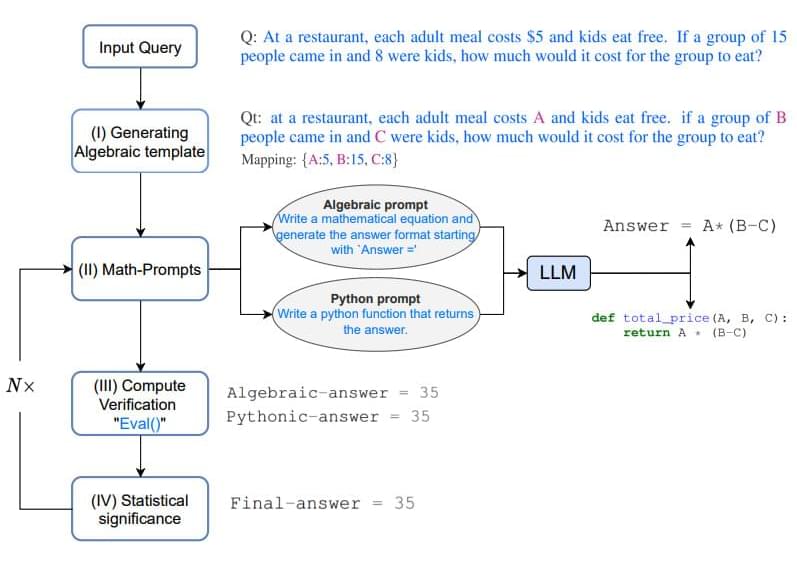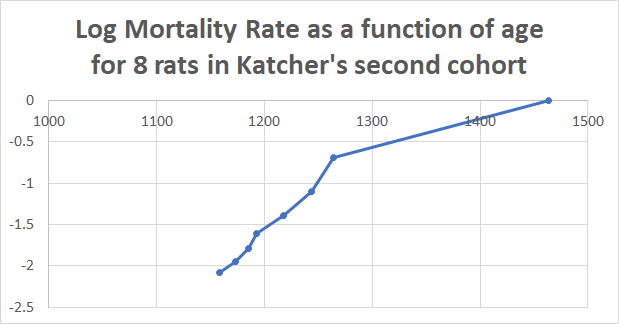Rushing the release of AI chatbots for search is a risky experiment fuelled by greed.


https://gotopnews.com/post/1979903
Scientists created mice with two biological dads by producing eggs from male cells, which is a development that opens radical new possibilities for reproduction. Progress can ultimately pave way for treatments for severe infertility forms and increase possibility of attracting couples of same gender to have a biological child in future. Hayashi, who presented development at the third International Human Genome Regulation Summit at Francis Crick Institute in London on Wednesday, predicts it would be technically possible to create a human egg from a male skin cell in ten years. Considering that human eggs did not create eggs, he argued this timeline was optimistic. Previously, scientists have created mice technically with a detailed step chain, including genetic engineering. This is first time that can be applied first time, eggs were raised from male cells and pointing to an important progress. He was trying to reproduce with human cells, but there would be important obstacles for use of eggs grown in laboratory clinical purposes, including creating safety. “In terms of technology, it will be possible even in 10 years in 10 years, ve he personally added that the technology used clinically to allow two men to have a baby. Orum I don’t know if they are ready reproduction,” he said.“This is a question not only for the scientific program, but also[society].” Technique, X chromosome is missing or partially missing a copy of the turner syndrome, including women with severe infertility forms can be applied to treat and Hayashi, this application is the primary motivation for research, he said. Others argued that translating technique into human cells may be challenging. Human cells need much longer agricultural periods to produce a mature egg, which can increase the risk of undesirable genetic changes. Profess George Daley, the Dean of Harvard Medical Faculty, described the study as “fascinating„ but other researches also showed that creating gamet creating from human cells in laboratory is more difficult than mouse cells.said. The study, which was sent to be leading magazine, was based on a number of complex steps to transform skin cell that carries the combination of male XY chromosomes into an egg. Men’s skin cells were re-programmed into a stem cell-like condition to form the induced pluripotent root cells. Then the Y chromosome of these cells was deleted and changed and ” borrowed from another cell to produce IPS cells with two identical X chromosome. Hayashi said, ” The trick, greatest trick, the reproduction of X chromosome,” he said. ” We really tried to establish a system to replicate the X chromosome.” Finally, cells were grown in an ovary organoid with a cultural system designed to replicate the conditions within ovary. When Yumurtas were fertilized with normal sperm, scientists obtained approximately 600 embryos implanted in the mice, which resulted in birth of seven mouse offspring. ‘Efficiency was lower than the efficiency obtained by normal female-derived eggs, where approximately 5% of the embryos continued to produce a lively birth. Baby mice looked healthy, had a normal life, and as an adult continued to the offspring. ” They look good, they grow normal, they become a father, Hay Hayashi said. He and his colleagues are now trying to increase the creation of eggs grown in the laboratory using human cells. Working on Gamets grown in the laboratory at the University of California Los Angeles, Prof Amander Clark said that it would be a ” big jump in, because scientists have not yet created human eggs from women’s cells. Scientists have created the premises of human eggs, but so far, cells, mature eggs and sperm, a critical cell division step, which has stopped development before the point of meiosis. It can be 10 years or 20 years.”
Ray Kurzweil — The Singularity IS NEAR — part 2! We’ll Reach IMMORTALITY by 2030
Get ready for an exciting journey into the future with Ray Kurzweil’s The Singularity IS NEAR — Part 2! Join us as we explore the awe-inspiring possibilities of what could be achieved before 2030, including the potential for humans to reach immortality. We’ll dive into the incredible technology that could help us reach this singularity and uncover what the implications of achieving immortality could be. Don’t miss out on this fascinating insight into the future of mankind!
In his book “The Singularity Is Near”, futurist and inventor Ray Kurzweil argues that we are rapidly approaching a point in time known as the singularity. This refers to the moment when artificial intelligence and other technologies will become so advanced that they surpass human intelligence and change the course of human evolution forever.
Kurzweil predicts that by 2030, we will reach a crucial milestone in our technological progress: immortality. He bases this prediction on his observation of exponential growth in various fields such as genetics, nanotechnology, and robotics, which he believes will culminate in the creation of what he calls “nanobots”.
These tiny robots, according to Kurzweil, will be capable of repairing and enhancing our bodies at the cellular level, effectively making us immune to disease, aging, and death. Additionally, he believes that advances in brain-computer interfaces will allow us to upload our consciousness into digital form, effectively achieving immortality.
Kurzweil’s ideas have been met with both excitement and skepticism. Some people see the singularity as a moment of great potential, a time when we can overcome our biological limitations and create a better future for humanity. Others fear the singularity, believing that it could lead to the end of humanity as we know it.
Regardless of one’s opinion on the singularity, there is no denying that we are living in a time of rapid technological change. The future is uncertain, and it is impossible to predict with certainty what the world will look like in 2030 or beyond. However, one thing is clear: the singularity, as envisioned by Kurzweil and others, represents a profound shift in human history, one that will likely have far-reaching implications for generations to come.
0:00 Intro.
Are you ready to discover the potential technological developments that could shape the world we live in and get a glimpse of what life in the year 2100 might be like? As we approach the turn of the century, the world is expected to undergo significant changes and challenges. In this video, we will show you how the merging of humans and artificial intelligence can help solve any problem that comes our way and even predict the future.
Imagine being able to access the thoughts, memories, and emotions of billions of people through the hive mind concept. This will provide a unique way of experiencing other people’s lives and gaining new perspectives. Hyper-personalized virtual realities customized to fulfill every individual’s desire will be the norm. Users will enter a world where their every wish and fantasy constantly comes to life, maximizing their happiness, joy, and pleasure.
Education as we know it will change forever with the ability to download skills and knowledge directly into a person’s brain. People will be able to learn new skills and gain knowledge at unprecedented speeds, becoming experts in any field within seconds. The discovery and use of room-temperature superconductors will revolutionize many industries and transform the world’s infrastructure, especially in transportation. By 2100, this technology will be a reality and used in numerous industries.
Join us until the end of the video, where the final development will really raise your eyebrows. The future is exciting, and it’s happening now. Don’t miss out on this incredible journey!
As always, thanks for stopping by at Future Tech Enthusiast! Where we are truly enthusiastic about the Future of Technology!
Check out our website at: https://futuretechenthusiast.com/
This show is sponsored by Numerai, please visit them here with our sponsor link (we would really appreciate it) http://numer.ai/mlst.
Prof. Karl Friston recently proposed a vision of artificial intelligence that goes beyond machines and algorithms, and embraces humans and nature as part of a cyber-physical ecosystem of intelligence. This vision is based on the principle of active inference, which states that intelligent systems can learn from their observations and act on their environment to reduce uncertainty and achieve their goals. This leads to a formal account of collective intelligence that rests on shared narratives and goals.
To realize this vision, Friston suggests developing a shared hyper-spatial modelling language and transaction protocol, as well as novel methods for measuring and optimizing collective intelligence. This could harness the power of artificial intelligence for the common good, without compromising human dignity or autonomy. It also challenges us to rethink our relationship with technology, nature, and each other, and invites us to join a global community of sense-makers who are curious about the world and eager to improve it.
Pod version: https://podcasters.spotify.com/pod/show/machinelearningstree…on-e208f50
Support us! https://www.patreon.com/mlst.
MLST Discord: https://discord.gg/aNPkGUQtc5
TOC:
Intro [00:00:00]
Numerai (Sponsor segment) [00:07:10]
Designing Ecosystems of Intelligence from First Principles (Friston et al) [00:09:48]
Information / Infosphere and human agency [00:18:30]
Intelligence [00:31:38]
Reductionism [00:39:36]
Universalism [00:44:46]
Emergence [00:54:23]
Markov blankets [01:02:11]
Whole part relationships / structure learning [01:22:33]
Enactivism [01:29:23]
Knowledge and Language [01:43:53]
ChatGPT [01:50:56]
Ethics (is-ought) [02:07:55]
Can people be evil? [02:35:06]
Ethics in Al, subjectiveness [02:39:05]
Final thoughts [02:57:00]
References:
Go to https://brilliant.org/IsaacArthur/ to get a 30-day free trial + the first 200 people will get 20% off their annual subscription.
If the end of the world is nigh, it may be too late to avert a catastrophe. So what can we do to mitigate the damage or recover after a cataclysm comes?
Visit our Website: http://www.isaacarthur.net.
Join Nebula: https://go.nebula.tv/isaacarthur.
Support us on Patreon: https://www.patreon.com/IsaacArthur.
Support us on Subscribestar: https://www.subscribestar.com/isaac-arthur.
Facebook Group: https://www.facebook.com/groups/1583992725237264/
Reddit: https://www.reddit.com/r/IsaacArthur/
Twitter: https://twitter.com/Isaac_A_Arthur on Twitter and RT our future content.
SFIA Discord Server: https://discord.gg/53GAShE
▬ Cataclysm Index ▬▬▬▬▬▬▬▬▬▬
0:00 — Intro.
03:43 — Nuclear War.
11:24 — Asteroid.
15:34 — Supernova.
18:34 — Gamma Ray Burst.
21:51 — Massive Climate Shift.
23:15 — Snowball Earth.
24:34 — Super Volcano.
28:51 — BioWar.
30:46 — Zombie Apocalypse.
32:25 — Robots / AI
35:10 — Alien Invasions.
Listen or Download the audio of this episode from Soundcloud: Episode’s Audio-only version: https://soundcloud.com/isaac-arthur-148927746/journey-to-alpha-centauri.
Episode’s Narration-only version: https://soundcloud.com/isaac-arthur-148927746/journey-to-alp…ation-only.
Credits:
Surviving An Apocalypse.
Science & Futurism with Isaac Arthur.
Episode 385a, March 12, 2023
Written, Produced & Narrated by Isaac Arthur.
Editors:

LLMs stands for Large Language Models. These are advanced machine learning models that are trained to comprehend massive volumes of text data and generate natural language. Examples of LLMs include GPT-3 (Generative Pre-trained Transformer 3) and BERT (Bidirectional Encoder Representations from Transformers). LLMs are trained on massive amounts of data, often billions of words, to develop a broad understanding of language. They can then be fine-tuned on tasks such as text classification, machine translation, or question-answering, making them highly adaptable to various language-based applications.
LLMs struggle with arithmetic reasoning tasks and frequently produce incorrect responses. Unlike natural language understanding, math problems usually have only one correct answer, making it difficult for LLMs to generate precise solutions. As far as it is known, no LLMs currently indicate their confidence level in their responses, resulting in a lack of trust in these models and limiting their acceptance.
To address this issue, scientists proposed ‘MathPrompter,’ which enhances LLM performance on mathematical problems and increases reliance on forecasts. MathPrompter is an AI-powered tool that helps users solve math problems by generating step-by-step solutions. It uses deep learning algorithms and natural language processing techniques to understand and interpret math problems, then generates a solution explaining each process step.


A new mechanism that gives rise to superconductivity in a material where the speed of electrons is almost zero has been discovered by scientists at The University of Texas at Dallas and their partners at The Ohio State University. This breakthrough could pave the way for the development of novel superconductors.
The results of their study, which was recently published in the journal Nature, describe a novel approach to calculate electron speed. This study also represents the first instance where quantum geometry has been recognized as the primary contributing mechanism to superconductivity in any material.
The material the researchers studied is twisted bilayer graphene.